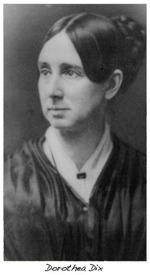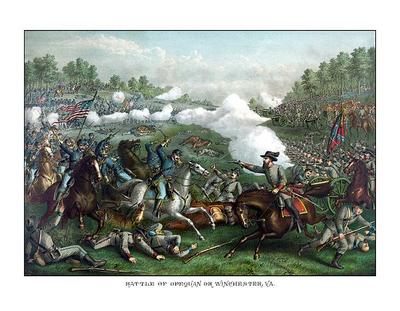For Oakwood Cemetery, Niagara Falls, NY by Michelle Kratts
Have you ever thought of placing a flag beside a veteran’s grave on Memorial Day? Maybe this year will be a first for you. In years past there was no greater event than Memorial Day. Thousands lined the streets in a procession that led to Oakwood Cemetery. Every single home and business along the way proudly draped itself in the red, white and blue. This was the day our city honored our most esteemed citizens, our veterans. There were some special homes, some special graves, that the veterans, themselves, insisted upon honoring each Memorial Day. They belonged to three most spectacular women: Elizabeth Letitia Porter, Margaret Elizabeth Breckinridge, and Julia Averill Griffen. They were Army nurses during the Civil War, angels of the battlefield, and now Oakwood’s special angels.
Elizabeth, Margaret, and Julia were the cream of the crop of Niagara Falls society. They were not ordinary women at all and the wounded men knew that. They sacrificed lives of comfort and privilege, of pianos and afternoons memorizing love poems, for every sort of degradation, disease and despair the world could offer. They gave a chapter of their girlhood to shoes caked in a strange mix of dirt and blood, dresses splashed with the insides of men, to typhoid and erysipelas. Saturday night dances included struggling with a broken down man on the way to the surgeon’s table. There were times they were able to make it home to Niagara, to recover from illness and exhaustion, but they inevitably found themselves longing to return to the battle lines. The love of their country and their fellow man was tattooed onto their souls and stayed with them even into Death.
Elizabeth, the exceptionally intelligent, highly cultivated daughter of General Porter (hero of the War of 1812, Secretary of War under John Quincy Adams) and Letitia Breckinridge (a southern belle with an impeccable pedigree), was born at Black Rock (Buffalo) on April 19, 1823. For a time she was rumored to have been “the woman Mr. (Millard) Fillmore intended to lead to the altar.” Perhaps a bit reckless in speech, she was known to often boast to European royalty that her family “owned the Falls.” When the war broke out she was firm and steadfast in her convictions. In May of 1861, she inherited two slaves from her grandfather’s Kentucky estate and promptly freed them. She was at the forefront of the women’s aid society in Niagara Falls and in 1862 left with her brother’s regiment for Baltimore where she served for many months as an Army nurse. In 1863, when she was back in Niagara Falls on sick leave, she roused herself to come to the aid of a returning infantry unit that had also returned with most of its men gravely ill. She nursed them back to health and even insisted that they take her carriage and team for a tour of the Falls. In June of 1864, she bravely brought her dear brother, Col. Peter A. Porter’s, lifeless body back to Niagara Falls where he was laid to rest in Oakwood Cemetery. Her experiences during the war rendered her an invalid and she died in Niagara Falls on January 28, 1876. She sleeps in the Porter plot at Oakwood, a giant in our history, sadly mostly forgotten by residents of the city she loved most of all.
 Margaret Breckinridge was Elizabeth and Peter’s first cousin. Born in Philadelphia on March 24, 1832, her grandfather had been a senator from Kentucky and the Attorney General of the United States under Thomas Jefferson. When her beloved older sister married their dashing cousin, Peter A. Porter, Margaret also came to live in Niagara Falls. She found the beautiful Porter home to be a most interesting resort for the meeting of literary and scientific minds, a shelter for the poor and homeless, possibly the hub of Niagara’s Underground Railroad, and the center of all local society. With the outbreak of war, she, too, along with her cousins, volunteered her services. Most of the time she served as a nurse on the hospital boats that travelled up and down the Mississippi. Soldiers never forgot her. She sang to them, read to them. They said it seemed she didn’t walk, she flew. How strange they thought it was for such a high-class lady to come and find herself bothered by them! In a letter to a friend she wrote of this and remarked that she had “come so many miles on purpose to be bothered.”
Margaret Breckinridge was Elizabeth and Peter’s first cousin. Born in Philadelphia on March 24, 1832, her grandfather had been a senator from Kentucky and the Attorney General of the United States under Thomas Jefferson. When her beloved older sister married their dashing cousin, Peter A. Porter, Margaret also came to live in Niagara Falls. She found the beautiful Porter home to be a most interesting resort for the meeting of literary and scientific minds, a shelter for the poor and homeless, possibly the hub of Niagara’s Underground Railroad, and the center of all local society. With the outbreak of war, she, too, along with her cousins, volunteered her services. Most of the time she served as a nurse on the hospital boats that travelled up and down the Mississippi. Soldiers never forgot her. She sang to them, read to them. They said it seemed she didn’t walk, she flew. How strange they thought it was for such a high-class lady to come and find herself bothered by them! In a letter to a friend she wrote of this and remarked that she had “come so many miles on purpose to be bothered.”
 When Peter was killed at Cold Harbor in June of 1864 she was heartbroken. Perhaps her relationship with him was more intimate than publicly revealed for loved ones hesitated to break the news knowing it would utterly devastate Margaret. And it did. She met Elizabeth in Baltimore and accompanied Peter’s body back to Niagara Falls. The blow was ultimately too great for her and her broken down body succumbed to disease and exhaustion. She died of typhoid fever on July 27, 1864, just a month after Peter. She was only 32 years old. I believe her tomb may be the most beautiful in all of Oakwood. It is inscribed as follows: “A life most precious and most beautiful such as consecrated to God and to duty and laid down in its prime in her devotion to her country and to humanity.”
When Peter was killed at Cold Harbor in June of 1864 she was heartbroken. Perhaps her relationship with him was more intimate than publicly revealed for loved ones hesitated to break the news knowing it would utterly devastate Margaret. And it did. She met Elizabeth in Baltimore and accompanied Peter’s body back to Niagara Falls. The blow was ultimately too great for her and her broken down body succumbed to disease and exhaustion. She died of typhoid fever on July 27, 1864, just a month after Peter. She was only 32 years old. I believe her tomb may be the most beautiful in all of Oakwood. It is inscribed as follows: “A life most precious and most beautiful such as consecrated to God and to duty and laid down in its prime in her devotion to her country and to humanity.”
Perhaps one of the most interesting of the angels of Oakwood is Julia Averill Griffen. Born in Hudson, New York, to Jane Hardick and Isaac Griffen, her paternal grandfather was a Quaker. When she was 13 her family moved to Stamford, Ontario, where her uncle, Cornelius, owned and lived in the Clifton House. During the Gold Rush of 1849, Cornelius attempted to make his way out to California, but met his demise before he arrived. His wife moved to Suspension Bridge and the other Griffens followed her to Niagara Falls. At the onset of war, Julia’s brother, Cornelius enlisted, and then, she decided that she must serve as well.
 She went to New York City for training and then on to Washington, D.C., where she worked under Dorothea Dix. She spent much time on the front and was taken prisoner following the battle of Winchester. After being paroled, she served more time at the front with the army of the Potomac. The men of Col. Porter’s 8th NY Heavy Artillery met with her among the wounded and the prisoners and made note of her kindness and skill. When the war had ended, she found herself chronically ill with asthma due to time spent upon the battlefield. She fought the US government year after year for the right to a pension. Finally, in 1888, by a special act of Congress, she was awarded a military pension. She was so beloved for her service to her country that on Memorial Day celebrations the veterans of the G.A.R. honored her by lowering their flags upon passing her home. She died on December 18, 1891, at the age of 60 and is buried in Oakwood Cemetery.
She went to New York City for training and then on to Washington, D.C., where she worked under Dorothea Dix. She spent much time on the front and was taken prisoner following the battle of Winchester. After being paroled, she served more time at the front with the army of the Potomac. The men of Col. Porter’s 8th NY Heavy Artillery met with her among the wounded and the prisoners and made note of her kindness and skill. When the war had ended, she found herself chronically ill with asthma due to time spent upon the battlefield. She fought the US government year after year for the right to a pension. Finally, in 1888, by a special act of Congress, she was awarded a military pension. She was so beloved for her service to her country that on Memorial Day celebrations the veterans of the G.A.R. honored her by lowering their flags upon passing her home. She died on December 18, 1891, at the age of 60 and is buried in Oakwood Cemetery.
Usually, it is our custom to honor soldiers on Memorial Day, but the soldiers of Niagara Falls made a habit of honoring these three women. Years have passed and most of us have never heard these names, yet there were men who had them upon their lips as they marched into heaven. It was 150 years ago when three angels came from Niagara Falls and gave their lives for their country. Perhaps on May 31, 2011, we should remember Elizabeth, Margaret and Julia and place a flag upon their graves. It’s the least that we can do.

